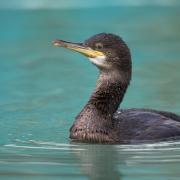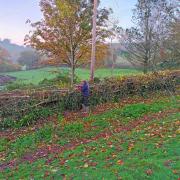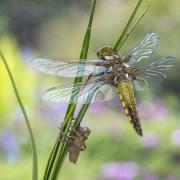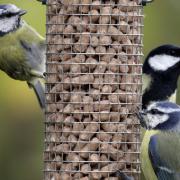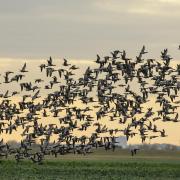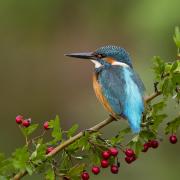To mark the centenary of his birth, the RSPB's Tony Whitehead tells the story of David Lack, an ornithologist whose studies of the robin were carried out on the Dartington Estate
Like Santa and reindeer, robins are Christmas – the link between bird and celebration go back at least to Victorian times. Some of the earliest Christmas cards featured images of robins delivering the mail, a nod to the red tunics worn by postman that earned them the name ‘redbreasts’. And it’s around Christmas when robins become more visible, their flame-orange-red plumage bringing a dash of colour to the dullest, shortest winter days.
As well as their special place in the folklore of the festive season, robins also have a special place in the history of ornithology, the study of birds, and much of this was due to the interests of a young teacher at Dartington in the 1930s.
David Lack, after graduating in Natural Sciences from Cambridge, took up the post of biology teacher at Dartington School in September 1933. Founded in 1926, the boarding school was under the progressive guidance of owners Leonard and Dorothy Elmhirst, and formal classroom activity was of less importance than wider involvement in the inspirational and creative affairs of the Dartington Hall estate.
The book is dedicated to “All those robins that patiently bore my rings and permitted my intrusions into the intimacies of their lives”
Lack had a lifelong interest in birds; as a child he knew the names of most birds and kept an alphabetically ordered list of those he had seen. This interest, combined with a need to find suitable out-of-class activities for his pupils, resulted in the first studies of robins around the estate. These involved careful observation of birds in the field and their behaviour through the seasons. He used coloured rings to identify individuals (one of the very earliest uses of the method) and built two large aviaries to do some specific work on aspects of the birds’ behaviour.Between 1934 and 1938 he made hundreds of observations were made, all of which were carefully written up. These studies resulted in a series of papers published in ornithological journals in the late ’30s and early ’40s. Following publication of these, Lack had the idea of re-writing them in a more popular and accessible manner for the public. This resulted in the publication, in 1943, of The Life of the Robin, one of the earliest monographs on a bird species.
The book is dedicated to “All those robins that patiently bore my rings and permitted my intrusions into the intimacies of their lives”. It is, as Lack intended, a marvellous read, combining scientific detail and natural history, with numerous references to the birds in English literature.The significance of The Life of the Robin, and the studies that resulted in its publication, lie in the original insights the work gave into robin behaviour, the dynamics of their populations and, particularly, how they occupy individual territories.
As is well known, robins sing throughout the year. Lack’s work showed that in winter both males and females sing and, crucially, that this is linked to defence of territory. As he writes: “The most important use of song to the robin in its territory is to advertise possession to rivals and warn them off.”
Previous to this it was largely assumed that, rather simplistically, male birds sang to attract mates. Linking territory to song in this way provided one of the foundations of subsequent study of birdsong. Developing the idea of territory ownership, Lack also brought to the fore just how aggressive robins are in defence of their territories. This was achieved through a series of well-known experiments that involved placing stuffed robins in the territories of live robins and observing the responses.Doing this he found that robins holding territory would physically attack the stuffed specimen, seeing no difference between this benign presence and a living intruder. Indeed, he discovered some birds would react in an identical way to a simple bundle of red feathers and remarkably, in one case, a hen bird attacked the empty space where the red feathers had been!
“The world of a robin is so strange and remote from our experience that into it we can scarcely penetrate, except to see dimly how different it must be from our own”
As he writes: “The world of a robin is so strange and remote from our experience that into it we can scarcely penetrate, except to see dimly how different it must be from our own.”
From working on robins, Lack went on to do important work on the finches of the Galapagos made famous originally by Darwin. Then, after the War, he led a distinguished career in ornithology as director of the Edward Grey Institute of Field Ornithology at Oxford University where he worked on the evolutionary aspects of population biology, including the development of the idea that natural selection favours birds whose clutch sizes ensure the greatest number of surviving young.
David Lack died in 1973. The Times wrote that he “greatly influenced the course of ornithological studies, and by his friendly and enthusiastic nature inspired many students to take up the study of birds...”. Indeed, he was a pioneer in making science accessible, making material useful to both the scientific community and the layman alike. The Life of the Robin is a testament to this.
For more on the cultural history of the robin, David’s son, Andrew Lack, recently published Redbreast: The Robin in Life and Literature.









